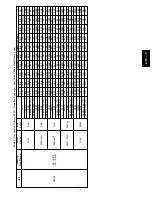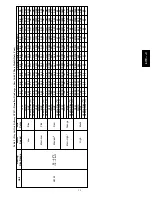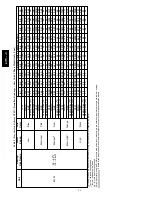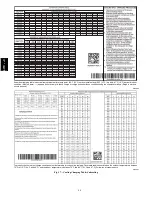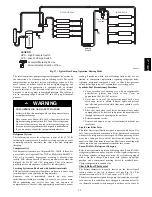
51
between the coils. Be sure to flush all dirt and debris from the unit
base.
Inspect the drain pan and condensate drain line when inspecting
the coils. Clean the drain pan and condensate drain by removing all
foreign matter from the pan. Flush the pan and drain tube with
clear water. Do not splash water on the insulation, motor, wiring, or
air filter(s). If the drain tube is restricted, clear it with a “plumbers
snake” or similar probe device. Ensure that the auxiliary drain port
above the drain tube is also clear.
BLOWER
HOUSING
2 SETSCREWS
(HIDDEN)
C99085
Fig. 20 -- Removal of Motor and Blower Wheel
A07680
Fig. 21 -- Burner Rack Removed
FEEDER TUBE
STUB TUBE
DEFROST
THERMOSTAT
C99029
Fig. 22 -- Defrost Thermostat Location
Outdoor Fan
UNIT OPERATION HAZARD
Failure to follow this caution may result in damage to unit
components.
Keep the outdoor fan free from all obstructions to ensure
proper cooling operation. Never place articles on top of the
unit.
CAUTION
!
1. Remove 6 screws holding outdoor grille and motor to top
cover.
2. Turn motor/grille assembly upside down on top cover to
expose the fan blade.
3. Inspect the fan blades for cracks or bends.
4. If fan needs to be removed, loosen the setscrew and slide the
fan off the motor shaft.
5. When replacing fan blade, position blade back to the same
position as before.
6. Ensure that setscrew engages the flat area on the motor shaft
when tightening.
7. Replace grille.
Electrical Controls and Wiring
Inspect and check the electrical controls and wiring annually. Be
sure to turn off the gas supply, and then the electrical power to the
unit.
Remove access panels (see Fig. 19) to locate all the electrical
controls and wiring. Check all electrical connections for tightness.
Tighten all screw connections. If any discolored or burned
connections are noticed, disassemble the connection, clean all the
parts, re--strip the wire end and reassemble the connection properly
and securely.
After inspecting the electrical controls and wiring, replace the
access panels (see Fig. 19). Start the unit, and observe at least one
complete heating cycle and one complete cooling cycle to ensure
proper operation. If discrepancies are observed in any operating
cycle, or if a suspected malfunction has occurred, check each
electrical component with the proper electrical instrumentation.
Refer to the unit wiring label when making these checkouts.
NOTE
: Refer to the heating and/or cooling sequence of operation
in this publication as an aid in determining proper control
operation.
Refrigerant Circuit
Annually inspect all refrigerant tubing connections.
EXPLOSION,
PERSONAL
INJURY
AND
ENVIRONMENTAL HAZARD
Failure to follow this warning could result in personal injury,
death or property damage.
System under pressure. Relieve pressure and recover all
refrigerant before system repair or final unit disposal. Use all
service ports and open all flow--control devices, including
solenoid valves.
!
WARNING
If low cooling performance is suspected, leak--test all refrigerant
tubing using an electronic leak--detector, halide torch, or
liquid--soap solution. If a refrigerant leak is detected, refer to the
Check for Refrigerant Leaks section.
If no refrigerant leaks are found and low cooling performance is
suspected, refer to the Checking and Adjusting Refrigerant Charge
section.
677C
--
--
C
Summary of Contents for Legacy 677C**C Series
Page 3: ...3 A150538 Fig 2 24 30 Unit Dimensions 677C C...
Page 4: ...4 A150539 Fig 3 36 60 Unit Dimensions 677C C...
Page 44: ...44 A150506 Fig 15 208 230 1 60 Connection Wiring Diagram 677C C...
Page 45: ...45 A150516 Fig 15 Cont 208 230 1 60 Ladder Wiring Diagram 677C C...
Page 46: ...46 A150507 Fig 16 208 230 3 60 Connection Wiring Diagram 677C C...
Page 47: ...47 A150517 Fig 16 Cont 208 230 3 60 Ladder Wiring Diagram 677C C...

